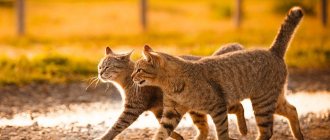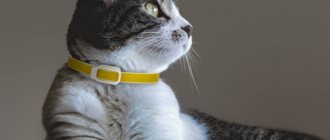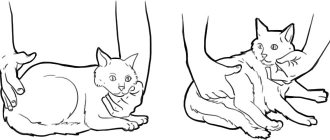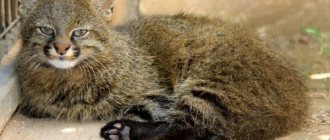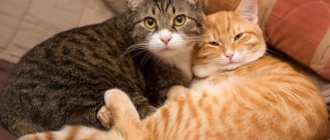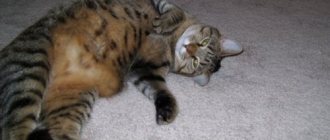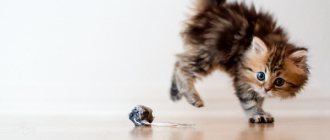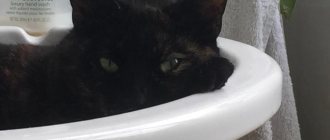A cat's body weight is of greater importance for their normal development and health. Like humans, felines can also have problems with weight (overweight or, less commonly, underweight). Obesity is a fairly common problem that occurs among domestic cats. In addition, you need to know how much the cat weighs in order to calculate the required dose of medications, the volume of food portions, also for traveling with an animal. How to determine the weight of a cat? This article will help answer this question.
Weight is determined by various factors:
- Breed.
- Availability of sterilization/castration.
- Floor.
- General health.
- Lifestyle (activity, diet).
- Age.
- Genetics.
© shutterstock
What are the norms for weight gain for kittens?
The first six months of a kitten's life are the most active in terms of growth. Accordingly, if the baby is healthy and develops normally, he will regularly gain weight:
Before the baby turns 1 month old, he rapidly gains weight - about 15 g per day. At the same time, by the end of the 1st week, the kitten should double its birth weight. Weigh him daily during this period. From 1 to 2 months, weight gain occurs systematically, on average 100–150 g per week. Weigh the baby once every 3 days. After 2 months, weight gain varies from person to person. It depends on the breed and nutrition of the animal. He is weighed weekly for up to 6 months, then once a month for up to a year.
It is important that there is weight gain. If it is absent, you should contact your veterinarian to find out the reasons.
Since there are no exact indicators of body weight gain (much depends on the individual characteristics of the animal, its living conditions and diet), the owner should focus on the average weight standards for kittens.
Table: average body weight of kittens in the first 6 months of life
| Age | Weight |
| 1–6 days | 70–130 g |
| 7 days | 85–200 g |
| 7–14 days | 225–400 g |
| 14–21 days | 285–500 g |
| 1 month | 500–750 g |
| 2 months | 1000–1500 g |
| 3 months | 1700–2300 g |
| 4 months | 2500–3600 g |
| 5 months | 3100–4200 g |
| 6 months | 3500–4800 g |
Short-term stabilization of weight in a kitten
The phenomenon of short-term weight stabilization often occurs. There is no need to panic if the kitten’s weight gain “frozen” for several days, and then continues in the same progression.
Such an anomaly can manifest itself at any time stage of the baby’s life. It often occurs when there is a transition from breastfeeding to regular food (dry food or natural food). This is due to the fact that the baby’s body goes through a period of adaptation to receiving new nutrients.
However, you should worry if there are no changes for more than a few days (for example, a week). This may mean that the kitten is malnourished or sick or infected with parasites. You should visit a veterinarian as soon as possible if, after weight stagnation, body weight begins to decrease rather than increase.
Table: kitten weights by month (values for popular breeds)
| Kitten age | Maine Coon cat weight (g) | Maine Coon cat weight (g) | British cat weight (g) | British cat weight (g) | Scottish cat weight (g) | Scottish cat weight (g) |
| Newborn kitten | 120–140 | 120–160 | 60–140 | 70–140 | 60–140 | 70–140 |
| 1 Week | 180–230 | 200–260 | 110–250 | 240–260 | 110–250 | 240–280 |
| 2 week | 280–340 | 400–360 | 150–360 | 340–400 | 140–360 | 340–400 |
| 3 week | 420–550 | 440–600 | 210–420 | 400–630 | 200–420 | 390–630 |
| 4 week | 560–680 | 630–750 | 250–600 | 550–740 | 240–600 | 540–740 |
| 2 months | 1100–1400 | 1200–1500 | 450–900 | 1000–1700 | 400–900 | 1000–1700 |
| 3 months | 1700–2300 | 1800–2300 | 1000–1500 | 1500–2500 | 1000–1500 | 1500–2500 |
| 4 months | 2700–3600 | 3000–3800 | 1700–2400 | 2100–3900 | 1700–2400 | 2100–3900 |
| 5 months | 2900–3900 | 3000–5500 | 2200–2900 | 2600–4300 | 2200–2900 | 2600–4300 |
| 6 months | 3200–4000 | 3900–6000 | 2300–3600 | 3000–5400 | 2300–3600 | 3000–5400 |
| 7 months | 3500–4100 | 4200–6500 | 2400–3900 | 3300–5600 | 2400–3900 | 3300–5600 |
| 8 months | 3800–4300 | 4500–6900 | 2500–4100 | 3500–6000 | 2500–4100 | 3500–6000 |
| 9 months | 4100–5000 | 5000–7000 | 2500–4300 | 3800–6400 | 2500–4300 | 3800–6400 |
| 10 months | 4200–5500 | 5200–7700 | 2500–4400 | 4100–6700 | 2500–4400 | 4100–6700 |
| 11 months | 4300–6000 | 5700–8000 | 2500–4500 | 4300–6800 | 2500–4500 | 4300–6800 |
| 12 months | 4500–6300 | 5700–9000 | 2500–4600 | 4500–7000 | 3500–4600 | 4500–7000 |
How to determine weight standards for a mongrel kitten
When it is not possible to determine what breed a kitten is, it is necessary to use average indicators. The size of the baby will change in accordance with its development. There are a number of factors that allow you to predict a kitten’s weight gain. For example, when he switches from breast milk to a normal diet, the weight may decrease slightly.
After the 6th month of life, weight gain is not of decisive importance. If the cat is active, eats well, and has no problems visiting the litter box, then there is no need to worry too much. The veterinarian should be observed on a schedule determined by the doctor (basically it coincides with the vaccination schedule).
Having mongrel cats and a dog adopted from the street, I regularly visit the veterinarian. All my animals have veterinary passports, are vaccinated and sterilized. This way I protect not only them, but also my family. After all, some diseases (and at least the same worms) can be transmitted to humans. Since my children play with animals, I have a strict order in this matter.
The effect of castration/sterilization on weight
Sterilization or castration itself does not affect weight gain, but adult cats after such a procedure need to reduce the calorie content of their daily diet by a third, since their metabolism and hormonal levels change.
© shutterstock
Dependence of weight on gender, lifestyle
Males are usually 1-2 kg larger than cats of the same breed. If the mother cat is large, then her kittens will most likely be large.
Pets that lead a sedentary lifestyle and do not have difficulty getting food, unlike stray cats, are more likely to gain excess weight.
Parameters of a healthy cat and cat.
Weight is a very important parameter in determining the health status of a cat. The average weight of a domestic cat is in the range of 2-7 kg. As a rule, both the size and weight of a cat are determined by its breed. So the Siamese and Angara breeds are considered the lightest. The heaviest are British and Maine Coon. They weigh more than 9 kg.
Losing weight for your cat will require willpower and dedication—yours, not hers. Your cat isn't going to lose those extra pounds, and she'll tell you so, probably quite loudly. Discuss your cat's health and diet with your veterinarian to develop a weight loss program to ensure your cat gets only the calories she needs each day and no more.
Increase play and exercise time with your cat, giving her the motivation to walk and jump regularly. Try placing your cat's favorite treat or dish somewhere high up so she has to work harder to get to it. You can also use catnip, which will increase your pet's overall mobility.
We suggest you read: Why a cat’s whiskers break, main reasons
Weight gain in the first month
The first four weeks of life are characterized by the most intensive growth. The weight of a kitten in the 1st month can increase up to 15 g every day. At the end of this period, it can be two or even three times greater than at birth. Such intensive growth is noticeable to the naked eye. If at this age there is a slight gain in body weight, then you need to seek help from a veterinarian to diagnose and correct the situation.
In the first month, the kitten needs intensive care and good nutrition. The optimal diet is provided by mother's breast milk. However, a cat cannot always feed its offspring for various reasons. In this case, the role of “mother” falls on the pet owner. The best substitute for mother's milk are special industrial mixtures, the composition of which duplicates the natural components as much as possible. The dosage and frequency of feeding depend on the age and size of the animal. So, in the first week he should be fed about 4 ml every 2-4 hours, and in the second week - every 4-6 hours, 5 ml. With proper nutrition, by the end of the fourth week he will weigh 300-400 g, his first teeth will grow and he can already be given additional food.
In addition to rapid growth, signs of your pet’s health in the first four weeks of life will include:
- ability to stand on one’s paws (way and not confidently);
- active behavior;
- healthy sleep;
- regular bowel movements.
Features of kitten growth
Representatives of both the Scottish and British breeds are distinguished by their large and muscular physique. Adult straight-eared and lop-eared individuals weigh between 5–7 kg.
Weight gain is especially noticeable in the first year of an animal’s life. Therefore, at this time the kitten should receive the optimal amount of nutrients and supplements (minerals, vitamins). A balanced diet will allow the kitten not only to develop properly, but also to maintain health at a high level.
Knowing how much a Scottish cat weighs at a given age can help you avoid a lot of problems.
Therefore, it is important to track this indicator during the first year of your furry pet’s life.
Video “Care for Scottish cats”
From this video you will learn about the breed characteristics of Scottish Fold kittens, about care and proper nutrition.
In the first days after birth
The weight of newborn babies of this breed is directly dependent on the size of the litter. The fewer cubs are born, the greater their mass.
A newborn kitten usually weighs in the range from 60 to 140 g. If this parameter goes beyond the limits, this is already a deviation. Although it is necessary to take into account the number of babies in the litter.
Also, the weight of babies depends on the well-being of the mother. If during pregnancy she ate properly, rested well and slept a lot, then the kittens will be healthy and well-fed.
Up to a month
During the first 14 days, babies gain weight very well. Every day they get heavier by 10–20 g
During this period, it is important to monitor the mother’s nutrition, as the kittens feed on her milk. Therefore, her diet should be as balanced as possible. On such mother's milk, the babies begin to grow very quickly
On such mother's milk, the cubs begin to grow very quickly.
Over the course of a week, a small Scots cat normally becomes 100–200 g heavier. By the age of 2 weeks, their weight can be 300–400 g. Females, naturally, will be slightly lighter than males. By the 21st day of life, babies will get stronger and can be introduced to complementary foods. At the same time, mother's milk should still remain the main food product.
For complementary feeding, you should use only high-quality natural products or dry food from special lines designed for growing kittens.
At three months
During the third month, babies continue to gain approximately 100 g per day. By the end of the month, animals can weigh from 800 g to 1 kg. During this period, the kittens are separated from their mother and accustomed to a high-quality diet rich in vitamins and microelements.
Veterinarians advise taking a balanced approach to compiling an animal’s diet at this age. You need to finally decide whether the kitten will eat natural food or dry food.
If natural products were chosen, then each portion is prepared immediately before delivery, which is not always convenient. Therefore, many owners of Scottish cats prefer to feed them high-quality dry food. You cannot combine both approaches in one diet, as this can lead to an imbalance of nutrients, which will negatively affect the health of your pet.
Due to changes in diet, weight gain in young representatives of the Scottish breed slows down during this period.
Up to six months
Starting from the fourth month, kittens become teenagers. At this age they usually weigh about 2 kg. Animals are characterized by mobility and activity. Therefore, they need more vitamins and calories, due to which their intensive growth occurs. In 8 weeks they are able to gain from 500 g to 2 kg. Their body size increases in proportion to weight gain, which does not affect the appearance of the pet in any way.
Health problems
An overweight cat can be quite funny when it lies down, rolls on its back, tries to lick hard-to-reach parts of the body, and of course while petting, but the truth is that an overweight cat is sick. Just like people, cats suffer from health risks associated with being overweight, including high blood pressure, diabetes and kidney problems.
Just because your cat can't tell you that he doesn't feel well doesn't mean he's healthy. Visit your veterinarian regularly to ensure you can prevent any health problems before they pass the point of no return.
Estimating a cat's weight.
You can roughly determine your physical fitness using a guide available at any veterinary clinic.
Overview of the cat's physical form (schematically):
Cat underweight
- The ribs, sternocostal joints and pelvic bones protrude and are clearly visible in smooth-haired cat breeds
- Severe loss of muscle mass
- There is no palpable fat layer on the chest
The lower limit of a cat's normal weight
- Ribs, sternocostal joints and pelvic bones are clearly visible
- The waist is clearly visible
- A thin layer of fat can be felt on the chest
- Almost no belly fat
Normal cat weight (ideal weight)
- Has good proportions
- The ribs, sternocostal joints and pelvic bones are not visible, but can be easily felt
- Waist is visible
- A thin layer of fat can be felt on the chest
- There is some belly fat
Overweight cat
- The ribs and spine can be felt with great difficulty
- The waist is almost invisible
- The fat layer can be felt on the chest, back and abdomen
- The ribs and spine are almost invisible under a thick layer of fat
- A well-defined fat layer can be felt on the chest, back and abdomen
- Abdominal volume is significantly increased
If it seems to you that your cat is getting fat, then start examining it regularly. Gently run your hands along her sides, trying to feel her ribs. With a cat of normal weight, you can easily feel the ribs. A small layer of fat on them should be palpable, which does not interfere with distinguishing each rib individually. If this is the case, then there is no reason to worry.
An obese cat is generally immediately obvious. She has a big belly, she can hardly walk, and she cannot lick herself completely. Often obesity is a consequence of a more serious disease, so it is worth contacting a veterinarian.
You need to help your cat lose excess weight. You cannot achieve sudden weight loss; the process should be gradual.
There are many foods available to reduce caloric intake. If feeding naturally, consult your veterinarian to determine an appropriate diet. It is easier to reduce the weight of a cat than for a person, since she has nowhere to go, just be firm and patient.
Please note that all this applies to an adult cat; kittens should not be restricted in their diet without the strict recommendation of a doctor. Kittens need all the food they can eat, including fat, to thrive.
Kitten weight at 2-3 months
During this period, intensive weight gain continues, although not as active as before. For every 30 days, the kitten almost doubles in size, and by the end of the 3rd month it will weigh approximately 1.5-2 kg. He can already eat soft food, so you should diversify his diet and don’t forget about water. Stores sell special food for kittens, which may come in the form of a pate or soft pieces in a sauce. Since the small pet is already actively exploring the territory, it is necessary to limit its access to adult food, which will be too tough for it.
Why monitor the development of newborn kittens?
Between birth and one month, kittens quickly gain weight. Regardless of the breed: Scottish, Thai, Fold, British, Bengal, Siberian or mongrel cats usually grow the same. Newborn babies weigh approximately 100 grams, grow day by day, and by a month can reach up to 500 grams.
Kittens gain 10-15 grams of weight every day.
If the cat doesn’t get it, there are a number of reasons for this:
- Congenital diseases.
- A large number of kittens in the litter.
- Poor maternal diet.
If the pet's weight is below normal, the pet may not be getting enough nutrition.
In the first case, the cat itself is lethargic, sleeps a lot, and not with all the kittens, but separately. In other cases, it is necessary to increase the daily diet for the mother cat.
For a nursing cat, nutrition increases by 25-30%.
Weekly weighing of kittens will allow you to find out whether the baby is developing normally and whether he has enough nutrition.
Obesity
Most indoor cats spend their days lounging on the couch, in the sun, or on your favorite bed, with few activities interrupting their rest. Of course, what cat would want to skip feeding or go to the litter box. You can imagine how difficult this is for your cat! But living this way can have a negative impact on your furry friend's weight, and soon you'll likely have a cat with more fat than muscle.
It is estimated that at least 30% of all domestic cats are overweight or obese. If you look down at your cat and can't see her waist, or can't feel her ribs with gentle finger pressure, your cat is too heavy.
The norm is 4-5 months
At this age, the average weight of a kitten is 1.5-3 kg. The period of intensive growth has ended, but the pet still continues to gain weight. At the end of the 5th month, males can reach 4 kg.
Your pet still needs to eat baby food frequently. The number of feedings is up to 5 times. Diets should be chosen with the maximum protein content, which is necessary for the normal development of the growing predator’s body. Industrially produced food is marked with the appropriate inscription “For kittens”. However, it is necessary to carefully study the composition in order to choose a quality nutrition.
How much should a cat weigh at different stages?
German Shepherd weight by month: table
During the first 15–20 days of life, kittens spend most of their time sleeping. After about 16 days from the moment of birth, babies begin to be interested in the events happening around them, frolic and play.
The table shows the weight of a growing kitten by month:
| Kitten age | Kitten weight by month | Note |
| 1st day of life | Approximately 99 g | Average weight of a newborn kitten |
| 7th day of life | 149 g | If a 7-day-old kitten weighs less than 99 g, he is either seriously ill or malnourished. |
| 14th day of life (0.5 months) | 170 g | The weight of a kitten is given, which is not sick with serious illnesses, but also does not receive the maximum portion of attention. |
| 21 days of life (0.7 months) | 225 g | With special care, kittens reach the specified weight at the age of 14 days |
| 35th day of life (1.2 months) | 450 g | The weight of an absolutely healthy, naturally strong kitten is indicated. |
| 2 months from the date of birth | 900 g | The cat no longer feeds her kittens; their future fate depends entirely on the owner. The permissible minimum weight at this age is 710 g |
| 3 months | 1400 g | The average weight of a typical kitten is indicated. |
| 4 months | 1800 g | Average weight |
| 5 months | 2300 - 2900 g | Male kittens weigh more than their sisters |
The table shows the average weight. The exact indicators depend on the breed, gender and health status of the kitten.
Outbred kittens develop in approximately the same way as purebred kittens, only their mortality rate is higher due to the lack of additional nutrition.
A weak kitten weighs very little from the first days of life
Note! An animal that at the time of birth weighed less than its littermates will not be able to do without additional nutrition. Pushed away from his mother's nipples by stronger brothers and sisters, he does not receive enough nutrition, does not gain weight and becomes weaker
Kittens stop needing mother's milk within a month after birth. By this time, their fangs and incisors have erupted, their ears take a vertical position (in representatives of straight-eared breeds), and their weight reaches 440-470 g. A kitten that has reached six months of age is considered an adult and weighs about 3 kg.
How to maintain normal weight
The cat's diet should include boiled vegetables and grains. The cat's diet should include fish or meat and rice, wheat, and oatmeal boiled in water.
Boiled pumpkin, cauliflower, broccoli and beets should also be eaten by the cat on an ongoing basis. Your pet may want to avoid eating grains and vegetables. In this case, when cooking rice, oatmeal and wheat, you can add a small amount of milk to the water, and mix the vegetables with the meat so that the animal cannot separate them.
The process of losing weight in an obese cat should be smooth; you cannot seriously injure your pet by depriving him of food.
To reduce the weight of the animal, you need to reduce the daily portion of food, eliminate high-calorie and fatty foods, and focus on a healthy diet.
Get your animal checked regularly by a veterinarian. An increased amount of proteins, fats and vitamins is the key to a cat’s healthy weight and well-being. Showing love for an animal through caring for its health will give your pet a happy, long life.
Cat weight at 8-12 months
By the time a cat is one year old, it is considered an adult. Its dimensions practically do not change, and on average reach 4-6 kg depending on the breed and gender. By the age of one year, it is necessary to reduce meals to two times a day and monitor its balance. It is important to feed animals with good food, in which the protein level is more than 30% (if we talk about industrially produced feed). High-quality balanced nutrition will be the key to the normal functioning of the cat’s body and is the prevention of obesity.
Briefly about the breed
The head of the Bengal is pointed, the neck is short and powerful, and the tail is of medium length.
The Bengal cat is a broad-shouldered and muscular pet.
The color of the cats resembles their leopard ancestors. The color range varies within brown shades. There are also snow and silver Bengals.
This is one of the cat breeds that lead an active lifestyle. Bengalis have developed mental abilities, inherited from their ancestors, who needed them to survive in the wild.
The paws of Bengal cats are particularly dexterous. Many representatives of the breed can easily move and carry objects, open and close doors.
During the process of domestication, the aggression inherent in their ancestors completely disappeared. Bengal cats are peaceful and playful, but they value freedom highly and are not very fond of being held.
Weighing procedure
To find out how much a kitten weighs, you can use a kitchen scale in the first months. A small pet will fit well in a bowl or bowl. In the future, you can use a canter scale by placing the animal in a bag with two handles or a basket. It is necessary to subtract the weight of the bag itself from the result obtained in order to obtain reliable data. Using the subtraction method, you can also weigh your pet using floor scales, which the owner first stands on himself, and then with the pet.
Weighing an animal may be required in the following cases:
- artificial feeding;
- pathologies at birth;
- suspicion of developing the disease;
- development control.
How to determine if a cat's weight is normal without a scale
BCS indices have been developed for specialists, with the help of which they determine the nutritional status of animals. At home, you can make a rough estimate. If a cat is underweight, the ribs, pelvic bones, and articulations of the ribs with the thoracic vertebrae are noticeable. It is not possible to feel the layer of fat.
In a cat with normal mass, the ribs and ends of the pelvic bones are invisible, but easily palpable. There is a waist, and thin deposits of fat are found on the chest, belly and tail.
An obese individual can be identified by the appearance of a rounded muzzle and a saggy belly. No hint of waist or ribs. Fatty deposits prevent bones from being felt.
These signs are convenient for determining the condition of a smooth-haired animal. What about the long-haired one? Carefully palpate the bones and the presence of fatty layers on the ribs and abdomen.
Weight standards for some breeds
How much a cat of a certain breed should weigh is presented in the table. We must understand that “normal weight” is a relative concept, depending on various factors. For example, a Maine Coon kitten weighs almost 2 kilograms at 3 months, and an adult Devon Rex can weigh the same. Both animals will be considered normal weight.
| Breed | Normal (average) weight, (kg) |
| Abessian | 4-7,5 |
| American Bobtail | 3-6,5 |
| Bengal | 3,5-6,5 |
| British Shorthair | 4-8 |
| British Longhair | 3-7 |
| Devon Rex | 2-3,5 |
| Munchkin | 2-4 |
| Maine Coon | 5-10 |
| Norwegian forest | 4-9 |
| Oriental | 4-8 |
| Persian | 4-7 |
| Russian blue | 4-8 |
| Siamese | 3-5 |
| Siberian | 3,5-9 |
| Sphinx | 3-5 |
| Scottish | 3-6 |
You may not know the normal weight for a cat in order to draw a conclusion about its health status. Determining the normal weight of a pet is quite simple, even without resorting to using a bathroom scale. It is necessary to independently examine the animal and find out what weight category it can be classified into.
Possible weight categories
- Underweight cat
. The bones are clearly visible and protruding. There are no fat deposits on the chest. - Normal weight for a cat.
The body has an hourglass shape when viewed from above (the lumbar waist is determined), muscular. Upon examination, the outlines of bones are slightly visible. The spine and ribs are easily palpable, the stomach is tucked, and there is a minimal layer of fat on it. - Increased weight of the cat
. The waist is determined. There are small fat deposits on the face, back and abdomen; the ribs are not visible, but are difficult to palpate. When viewed from the side, the abdomen is not pronounced. - Obesity is average
. The waist is wide, poorly defined at the top. The bones are not visible and practically cannot be felt. Moderate fat on belly, chest and base of tail. On the side, the abdomen is slightly enlarged. - Obesity is severe
. The waist is not visible from above. The bones are difficult to palpate. There is a pronounced layer of fat on the back, at the base of the tail, chest and abdomen. The chest and abdomen are wide. On the side, the abdomen is noticeably enlarged.
Cats generally grow until they are one year old. A domestic cat at 1 year weighs on average 3-6 kg, cats are 1-3 kg less
. If you are underweight or overweight (in a word – abnormal), you should definitely contact a veterinarian to determine the possible causes. The veterinarian will conduct an examination, carry out the necessary research and prescribe medications or diet adjustments. Even if your cat falls into the normal weight category, it should be seen by a veterinarian regularly.
A cat's body weight is of greater importance for their normal development and health. Like humans, felines can also have problems with weight (overweight or, less commonly, underweight). Obesity is a fairly common problem that occurs among domestic cats. In addition, you need to know how much the cat weighs in order to calculate the required dose of medications, the volume of food portions, also for traveling with an animal. How to determine the weight of a cat? This article will help answer this question.
Weight is determined by various factors
:
- Breed.
- Availability of sterilization/castration.
- General health.
- Lifestyle (activity, diet).
- Age.
- Genetics.
How to weigh a kitten correctly
Bengal kittens are born weighing from 70 to 120 g. By the first week of life, their weight doubles, and by the end of the month it reaches approximately 500 g. At the end of the first month, the process of weight gain gradually slows down.
Bengal kittens are born weighing from 70 to 120 g.
By 7-9 months, cats stop gaining weight, and cats continue to grow slowly until they are 2 years old.
According to the standards set by the World Cat Federation (WCF), the weight of a female should be 5 kg, and a male should be 8 kg. Body length varies from half a meter to 90 cm.
The weight of representatives of this breed largely depends on the genetic characteristics of the parents and can often exceed the average.
To control the development of the Bengal, you should follow simple rules:
- During the first two weeks of life, monitor the kitten's weight daily. Then the procedure can be carried out 2 times a week.
- Provide your nursing cat with high-quality and balanced nutrition. If kittens on natural feeding do not gain weight well, then the amount of proteins and vitamins in the cat’s diet should be increased.
- If a kitten loses weight, it is recommended to feed it with special food for kittens.
Having noticed deviations in weight gain, you should determine the reasons for this.
Bengals are one of the cat breeds that lead an active lifestyle. Several common reasons:
- Improper nutrition. Underweight is observed if the kitten is malnourished or does not receive enough nutritional components. Make sure that the kitten eats 6 times a day and has constant access to clean drinking water.
- Refusal to eat. This problem especially often occurs among owners who purchased a kitten from a breeder. The pet may already be accustomed to a certain food and refuse to eat a new one. In this case, you should transfer the kitten to a new food gradually.
- Stress. Sudden changes in environment and other factors can provoke stress. When stressed, kittens may refuse to eat. As a rule, adaptation takes from a couple of days to a week, after which the pet begins to eat normally and gain weight again.
- Diseases. If a Bengal eats properly, but still does not gain weight well, this may indicate diseases of the digestive system. In this case, you should definitely show your pet to a veterinarian.
- Parasites. Weight loss may indicate the presence of worms. Prevention against parasites should be carried out every six months starting from three weeks of age. For kittens, a suspension is used: it is easier to administer into the body.
Be sure to read:
All 6 Cat Breeds with Short Legs: Bambino, Munchkin, Napoleon, Lamkin, Kinkaloo and Skookum
It should also be taken into account that if the parents are quite large in size, and the kitten does not meet the weight standards for its age, then, presumably, it is from a large litter.
In the womb and during natural feeding, kittens from a large litter may not have received enough vitamins and other useful substances, therefore, there is a risk that their health will be poor.
A huge role in a kitten’s health is played by its pedigree.
When buying kittens, they examine the eyes and inner surface of the ear:
- Eyes should be clean, without signs of conjunctivitis. The eye color of a Bengal kitten is fixed by the age of 1.5-2 years. Until this age, the color may change from yellowish to green and blue. According to the standard, the Snow Bengal must have blue eyes.
- The inner surface of the ear should be clean; inflammation may indicate the presence of ear mites.
The kitten's color may seem uncharacteristic of the breed, but this is normal.
Bengals acquire their adult coloration when they reach two months of age.
If the kitten is very small, then in order to weigh it, you can use a regular kitchen scale and a small box. To prevent the kitten from turning weighing into a game, the best time for the process is immediately after sleep. If the baby starts spinning and jumping, the indicators will be inaccurate. Trying to hold a playful baby with your hand can also get a distorted result.
To get the most accurate figure for the baby’s weight, you can follow two methods:
- First, weigh the box, then put the kitten in it and record the result again. Subtract the difference.
- Place the box on the scales, and only then turn them on. They will show zeros. After this, we put the baby in a box and get the figure for his body weight. It is more convenient to weigh mobile kittens in small containers or boxes to get a more accurate result.
This way the owner will receive an exact figure in grams, which can be entered into the animal’s weight diary.
What weight should a cat be?
And, although we won’t tell you the exact indicator, there are some predetermining factors. Thus, the average weight of a domestic cat ranges from 2 to 7 kilograms. At the same time, the weight of individual individuals of the breed can reach 11 kilograms or more. So, for example, it is known that
However, from a veterinary point of view, such excessive fatness is a sign of obesity and poor health. So, don’t try to beat the world record by heavily fattening your pet.
But, let's return to the average weight for cats - the weight range is too large. Also, it is necessary to remember about the peculiarities of the individual body structure - even in one breed there are large individuals, and there are also small ones. An adult cat can weigh up to 2.7 kilograms, while a teenage cat can weigh more than 5 kilograms.
How to determine a cat's nutrition level
So, you and I need to determine the degree of fatness of the cat. If she is thin, she should be fed more; if she has signs of obesity, it’s time to put the cute meowing creature on a diet. To answer the question, simply pat your cat on the back. If during stroking you do not feel the animal’s spine under your hands, or the vertebrae are faintly palpable, it would not be a bad idea to put your pet on a diet or at least on a light diet. If, on the contrary, the vertebrae still stick out, your cat is malnourished and her body weight is below normal. True, this is also possible when the body is infected with worms (o) or with some other diseases. Therefore, you will also need to make sure that your cat is healthy and does not have worms.
How to weigh a cat
If you need to not only visually determine the degree of fatness of a cat, but also find out its exact weight, we suggest that you weigh the animal. However, let’s make a reservation right away – not all types of scales are suitable for such a procedure. You can take ordinary floor-standing electronic ones. But whether you can get the cat to stand on them calmly for a few seconds until the result appears on the board is not an easy task. Alternatively, you can weigh yourself with the cat in your arms, then weigh yourself (without the cat), and subtract the second from the first mass. The difference will be your cat's weight.
If you need to weigh not a big cat, but a small kitten, floor scales will not suit you. It is better to use ordinary kitchen electronic ones. Carefully place the kitten in the bowl and evaluate the result. Don't forget to reset the scales to zero before weighing your baby.
Maine Coon adult size
The world's largest breed, the Maine Coon, is surrounded by many myths and stories that also relate to the size of these animals. However, the average weight of an adult and fully developed male Maine Coon Cat ranges from 5.9-8.2 kg, and the body weight of a female ranges from 3.6-5.4 kg.
The height of an adult Maine Coon, as a rule, does not exceed 25-41 cm, with a total body length with tail of up to 100-120 cm . The maximum length of the tail of the average representative of the Maine raccoon cat breed most often does not exceed 35-36 cm. The Maine raccoon cat reaches its full size at the age of three to five years, which is quite late compared to other popular and widespread breeds.
This is interesting! Thoroughbred animals, when gaining a body weight of 8-9 kg, look much larger and more massive, which is due to the characteristic exterior, represented by an elongated and elongated body with large and well-developed muscles, strong limbs, as well as a massive neck, head and shoulders.
Return to content
BFI 70: >65% fat mass
thick fat layer, bone structures are not determined. Head and neck:
there is no border between the head and shoulder, a dense scruff with a pronounced layer of fat.
Sternum:
not defined, impossible to palpate, extremely thick layer of fat.
Shoulders: Ribs:
not defined, impossible to palpate.
Abdomen:
extremely thick fat, the contents of the abdomen cannot be palpated.
Base of the tail:
bone structures are not defined, can be palpated with great difficulty, the fat layer is extremely pronounced.
Side view:
the abdominal area is extremely enlarged.
Top view:
the back area is extremely enlarged.
Well? Breathed a sigh of relief? Or not?
Domestic cats are often predisposed to excess weight because they lead a sedate lifestyle and have constant access to food. Also, overfeeding them with tasty food plays an important role. To avoid problems with the animal's weight, owners need to know the average weight of the cat, which depends on its age, gender and breed. This will be discussed in the article.
For what reasons does a cat baby not gain weight?
Maine Coons usually grow well and quickly, and by the age of 2 months their weight can reach 1.5 kg. But it also happens that the Maine Coon does not gain weight, which is not the norm. Reasons thought to contribute to poor weight and height gain include:
- Poor food for mother cat.
Lactating female Maine Coons are fed at least 3 times a day with special food for lactating cats or food prepared by a caring owner (lean meat, fresh dairy products, cereals, occasionally fish and boiled eggs, vegetables and vitamins prescribed by a specialist); - If the cat is still too small, he may simply weakly suck his mother's milk.
Or the cat’s milk itself is not enough. To keep babies fed, some owners feed them with cat milk substitutes; - Harmful (toxic) mother's milk.
Milk can be dangerous if the animal suffers from mastitis, metritis, or uterine abscess - problems that are common after childbirth. The milk of an animal that is treated with any medications without the consent of a veterinarian is not at all beneficial; - Lack of vitamins and anemia.
If there are few useful components in mother's milk, Maine Coon babies can easily grow poorly and slowly, and be weak; - Worms.
These parasites are often transmitted to kittens from the mother through milk. Naturally, worms do not leave a chance for weight gain; - Genetic deviation.
It happens that among five kittens one weighs very little and looks too weak. This happens with people too, when one of the twins is in full health, and the other is on the verge; - Disease.
In fact, any disease that was transmitted to the baby from a cat or developed independently can affect weight gain. When the kitten is clearly not feeling well (stool problems, vomiting, temperature (normally it should be 38.5-39.5 degrees), discharge from the nose and eyes, plaintive meowing, etc.), you should quickly run to the veterinarian or call a doctor on house; - Crossing a Maine Coon female with an outbred male.
Usually such cases are excluded, but sometimes they still occur. A half-breed cat may well gain weight more slowly than its purebred counterpart.
The Internet is full of advice on what drug can be administered to a small Maine Coon. Trusting recommendations from cat forums is not always wise. Many medications can do more harm than good. In addition, without a correct diagnosis, treatment cannot begin.
How much does a cat weigh and developmental features?
1 month
An average monthly cat weighs 400-500 grams. He actively begins to explore the world, crawls out of the box on his own, and gets acquainted with adult food. At this age they love to play and sleep often, but little.
At 1.5, babies' eye color changes. They begin to look for the tray on their own and visit it regularly. This is a good age to look for new owners.
2 months
Pet weight 450-900 g.
At this age, kittens have heightened curiosity - they explore the world around them, try everything with their teeth and paws.
Playful, affectionate. Their outlines take on those of an adult cat.
Two-month-old kittens are already accustomed to combing, washing and trimming their nails.
Lack of exercise in cats can lead to excess weight
3 months
The weight of the cat is 1000-1500 g.
He is already playful and affectionate, accustomed to his owner and affection. Responds to a nickname, independently finds a tray, bowls of food and water.
Three-month-old kittens have fully formed eye color, as well as baby teeth.
By this age, boys surpass their sisters in size.
4 months
Hang 1700-2400 gr.
Kittens become less playful, although they like to chase toys around the house. They become like adult cats: they sleep more, go to the bowl less often, and become calm and affectionate.
The replacement of baby teeth with permanent ones begins.
5 months
They hang 2200-2900 gr.
Kittens are slightly smaller than an adult cat. At this age they are transferred to three meals a day.
The presence of any irritants in the house can reduce appetite and lead to lack of food intake.
Half a year
Hang 2300-3600 gr.
Six-month-old cats have finished changing their teeth.
They are proportionally harmonious and graceful in their movements. Hunting instincts are developed.
At 6 months, kittens end their active growth phase and gain significantly less weight.
7 months
Hangs 2400-3900 g.
Males and cats begin their first molt and puberty. If a girl and a boy live together, then they begin to be interested in each other, and the males court the females.
Now the pet needs regular brushing so that the fur it licks off does not cause stomach upset.
8 months
Hangs 2500-4100 g.
At this age, it is recommended to spay and neuter cats if they are not planned for breeding.
The period of active growth and weight gain plays a special role in the development of the baby.
9 months
2500-4300 gr.
At this age, kittens look like adult cats and gain almost no weight.
10 months
Hangs 2500-4400 g.
At this age, cats begin their first heat.
It is not recommended to breed cats before 12 months of age to avoid birth complications.
From the age of ten months, kittens participate in exhibitions in adult categories.
11 months
Hangs 2500-4500 g.
A fully formed adult animal that has stopped growing. Now you can switch your pet to adult food.
Year
Hangs 2500-4600 g.
Already an adult animal that eats food for adult animals is able to participate in mating and exhibitions.
Some breeds are fully mature by age two, such as Maine Coons.
Why does a kitten weigh less than normal and what to do about it?
There is no need to panic if the baby’s weight is slightly behind the norm, but he himself is cheerful, active and does not have any alarming symptoms such as vomiting, diarrhea, excessive salivation, dulling of fur, etc.
If the kitten is significantly underweight, If the ribs and pelvic bones are visible, you should immediately contact a veterinarian. Frequent reasons for such deviation:
- Starvation. A hungry kitten looks exhausted, lethargic, has bloating and diarrhea, and in severe cases, symptoms of rickets and anemia. Underweight may be due to a lack of mother's milk or an unbalanced diet when the kitten has already been weaned. It is necessary to increase the volume of mother's portions by 2–3 times during lactation. If this measure does not give the desired result, you need to supplement the baby with formula milk.
- Taste of milk. Sometimes a kitten refuses mother's milk because of its bitter taste, which appears due to the cat's postpartum illness (for example, mastitis or acute metritis). The baby looks exhausted, meows pitifully, and has bloating, diarrhea and redness of the anus. In order not to provoke blood poisoning, the baby is transferred to artificial feeding and detoxification therapy is carried out.
- Parasitic disease. A sick pet, despite a good appetite, does not gain weight. The baby has a tight belly, dull fur, sometimes constipation or diarrhea, traces of blood, mucus and parasite eggs are visible in the stool. The developmental delay is due to exhaustion: the incoming nutrients are spent not on the growth of the kitten, but on maintaining the vital activity of helminths. Worm infestation is especially dangerous at this age and can be fatal, so you should immediately contact a veterinarian.
- Diseases of the gastrointestinal tract. In this case, the kitten even loses body weight, because due to the disease, the mucous membrane of the digestive tract is affected, and nutrients are no longer absorbed by the body. A sick baby experiences symptoms such as vomiting, fever, excessive salivation, changes in stool, etc. A complete cure requires complex therapy, including not only treatment of the underlying disease, but also vitamin therapy and special nutrition.
Why do you need to monitor a kitten’s weight at different periods of its growth?
The weight of kittens is an indicator of their health.
Kittens can lose weight for the following reasons:
- congenital and acquired diseases;
- parasite infection;
- improper diet;
- breed or genetic abnormalities.
In order to timely identify deviations from the norm of nutrition and possible diseases, the owner of a Bengal cat is recommended to compare the kitten’s weight with the norms daily during the first weeks of life. In the future, the frequency of weighing can be reduced to 2 times a week.
Be sure to read:
Russian Blue cat: description of the breed and character, advantages of the breed
A kitten's weight is a very important aspect of its development. The baby's weight needs to be monitored for several reasons. For example, by the age of one month, a kitten can weigh up to 500 grams. If his weight differs from this indicator in the direction of decrease, this may be caused by the following reasons:
- diseases, congenital or acquired;
- numerous litters;
- the mother’s lack of a complete diet that can provide nutrition for both the cat herself and her babies.
An underweight kitten may indicate that the baby is malnourished. He becomes lethargic, sleeps a lot, and apart from the general mass of kittens. In this case, you need to increase the amount of food for the nursing cat and monitor how long the weak baby stays at her breast.
Once I brought foundlings to my nursing cat. They were left without a mother, and besides, unkind people simply abandoned them to their fate. The two babies quickly got used to it, actively sucked the cat and did not differ from her “native” kittens. One kitten was very weak, he could not defend his place at the nipple and was often left out of work.
Sometimes he still managed to get comfortable, but he quickly got tired and soon fell asleep without having eaten enough. Since I closely followed the adaptation of foundlings, I immediately noticed this (literally within 24 hours). The baby had to be fed separately. I gave him a special mixture, but also tried to get him to latch on to the cat’s breast more often (the more lively brothers had to be pushed aside for a while). As a result, this baby still lagged behind the others in weight, but caught up with them in height by about a year.
If a kitten is diagnosed with any disease, then to correctly calculate the medicinal suspension you will also need to know the exact weight of the animal. Therefore, a conscientious owner always monitors this indicator.
Every caring owner should keep a kitten's weight diary. This must be done regardless of whether the kitten grows up alone or with its mother cat and brothers. It is necessary to record all weight indicators in the diary, which can later help track whether the baby is developing normally.
The weight diary can be kept in any form, as convenient for the owner. This is an ordinary notebook for me. In it I write down the date of birth of the kittens, the names I gave them, as well as everything related to caring for them. This is not only their weight, but also the dates of treatment for fleas and worms, as well as the dosage of drugs (which, by the way, depends on weight).
Third month of life
Kids at this age are alert and active; they spend most of their time playing and exploring their property. They ride on curtains, climb on sofas, beds, carpets on the wall. Not only the weight but also the growth of the kitten increases, the formation of the skeleton and muscles occurs
During this period, it is important to introduce more foods rich in vitamins, minerals and proteins into your diet. You can continue to feed your pet natural products or choose food designed for three-month-old kittens
Combination nutrition is not recommended, since it is difficult to achieve the optimal balance of all necessary vitamins and microelements. Therefore, it is better to immediately make a choice: natural food or ready-made food (dry and wet). If you decide to feed with special foods, then you need to purchase premium formulations. This guarantees their quality and the future health of the animal.
By choosing ready-made food, the owner solves several problems at once:
- There is no need to compile a daily menu; it is enough to pour the amount of mixture indicated on the pack of food;
- time spent on shopping trips is reduced. It is enough to visit a pet store and purchase a supply of food so as not to go to the market every day in search of fresh food for your pet;
- the finished formulations are balanced, so there are no problems with nutritional quality.
By this age, the weight of the growing young is from 1.2 to 1.7 kg.
